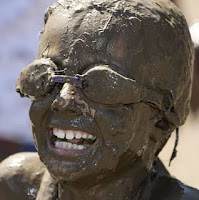1. Planting in the Garden: Dig the earth where you will plant the seeds into furrows or individual seed holes.
Planting in Pots: turn the earth in the pot and dig a hole.
2. Each child holds a few seeds in their hand and is shown where the seed should go and they put it in. (see picture above)
3. When all the seeds are planted work together to push the soil back over the seeds.
"Sam, at age 4, is already pretty good at handling the smaller seeds (carrots, onions, etc.) but Avery is just on her first planting year to be involved so she just helped with the bigger bean seeds.
Beans are, in my opinion, some of the best plants to grow with young kids. The seeds are big and easy to handle. The seeds sprout fairly quickly so that they don't have to be patient for too long. The beans are easy to pick off and a great immediate snack in the yard. My girls both loved helping to pick the beans last year and I know this year they will get just as into the process." Abbie at Greening Sam and Avery
Growing from Seeds PDF from Yates and Junior Landcare
Looking for a helpful book about gardening with children?

Gardening with Children (BBG Guides for a Greener Planet) from Amazon


































